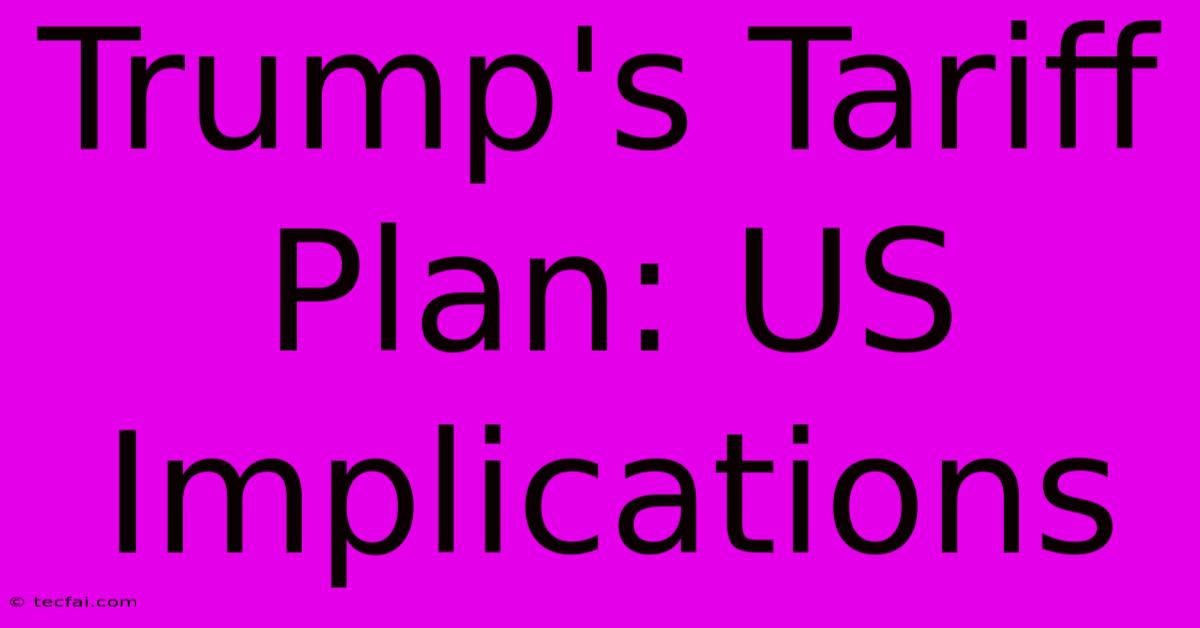Trump's Tariff Plan: US Implications

Discover more detailed and exciting information on our website. Click the link below to start your adventure: Visit Best Website tecfai.com. Don't miss out!
Table of Contents
Trump's Tariff Plan: US Implications – A Comprehensive Analysis
Donald Trump's presidency was marked by a significant shift in US trade policy, characterized by the widespread implementation of tariffs on imported goods. This article delves into the complexities of Trump's tariff plan, examining its intended goals, actual impacts on the US economy, and lasting implications.
Understanding the Rationale Behind the Tariffs
Trump's tariff strategy stemmed from a core belief in protectionism, arguing that it would revitalize American industries, create jobs, and reduce the US trade deficit. His administration targeted specific countries, notably China, imposing tariffs on a vast range of goods from steel and aluminum to consumer electronics and agricultural products. The stated aims were multifaceted:
- Protecting American Industries: The tariffs aimed to make imported goods more expensive, thereby boosting demand for domestically produced alternatives.
- Reciprocity and Fair Trade: The administration argued that many trading partners engaged in unfair trade practices, justifying retaliatory tariffs.
- National Security Concerns: Tariffs on certain goods, like steel and aluminum, were justified on national security grounds.
The Economic Impacts: Winners and Losers
The economic effects of Trump's tariffs were far-reaching and complex, impacting different sectors and groups in contrasting ways.
Winners (Perceived and Actual):
- Some Domestic Industries: Certain US industries, particularly those directly competing with imported goods, experienced a short-term boost in demand due to higher prices on imports. This was most evident in sectors like steel and aluminum production. However, the long-term effects were often less positive, as discussed below.
- Domestic Producers of Substitute Goods: Companies producing goods that could replace imports saw increased sales.
Losers:
- Consumers: Higher prices on imported goods directly increased the cost of living for American consumers. This impact was particularly felt by low- and middle-income households.
- Businesses Relying on Imports: Many businesses heavily reliant on imported materials or goods faced increased production costs, leading to reduced profitability and potential job losses in some sectors.
- Global Trade: The tariffs sparked retaliatory measures from other countries, disrupting global supply chains and harming international trade. This led to uncertainty and decreased global economic growth.
- Farmers: The trade war with China significantly impacted American farmers, who faced reduced export opportunities and lower prices for their products.
Unintended Consequences:
The tariffs generated several unintended consequences, including:
- Inflation: Increased import costs contributed to inflationary pressures within the US economy.
- Supply Chain Disruptions: Retaliatory tariffs and trade tensions led to significant disruptions in global supply chains, affecting businesses and consumers alike.
- Reduced Economic Growth: The overall impact on economic growth is debated, but many economists argue that the tariffs negatively impacted long-term growth.
Lasting Implications and Lessons Learned
Trump's tariff strategy has left a lasting legacy on US trade policy and international relations. While the immediate impact on certain domestic industries may have been positive in some instances, the long-term effects on the overall economy were largely negative. The experience highlights the complexities of protectionism and the interconnected nature of the global economy. Key takeaways include:
- The importance of multilateral trade agreements: The tariffs demonstrated the potential downsides of unilateral trade actions and the benefits of collaborative approaches to resolving trade disputes.
- The interconnectedness of global supply chains: The disruptions caused by the tariffs underscored the vulnerability of businesses and economies reliant on complex international supply chains.
- The need for a nuanced approach to trade policy: A simplistic approach to trade, focusing solely on protectionism, can have significant unintended negative consequences.
The Trump administration's tariff plan serves as a cautionary tale, illustrating the potential pitfalls of protectionist policies and emphasizing the importance of a more balanced and nuanced approach to international trade. The long-term impacts are still unfolding, but the experience has undoubtedly shaped the current debate surrounding US trade policy.

Thank you for visiting our website wich cover about Trump's Tariff Plan: US Implications. We hope the information provided has been useful to you. Feel free to contact us if you have any questions or need further assistance. See you next time and dont miss to bookmark.
Featured Posts
-
Sporting Cp Vs Arsenal Final Score
Nov 27, 2024
-
Ayubs Century Levels Series
Nov 27, 2024
-
London Elizabeth Line Full Day Suspension
Nov 27, 2024
-
Whats Happening At Morrisons
Nov 27, 2024
-
Richard Coles Grief After Partners Death
Nov 27, 2024
